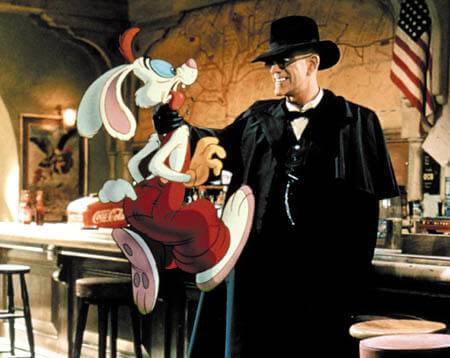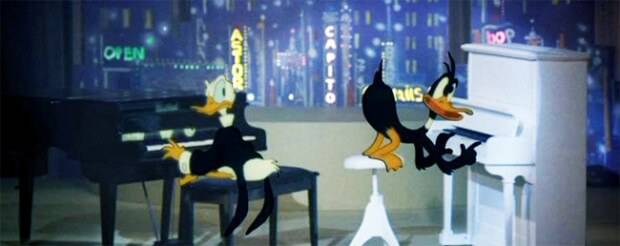Who Framed Roger Rabbit Retrospective
It is quite the time for anniversaries, not only is this week the 25th anniversary of the release of Who Framed Roger Rabbit but this year has seen the animation director Richard Williams celebrate his 80th birthday. With a rich an varied career that includes commercials, features, short films and multiple award wins the film that may always define Williams career as well as jump starting the 2nd animation renaissance and the career of many of todays most influential animators must be Who Framed Roger Rabbit. Richard Williams himself will be talking at this years Edinburgh International Film Festival to give some rare insight into his career on the 29th June.
 With all this in mind we decided it was a good opportunity to take a look back at one of the most influential animated films of all time!
With all this in mind we decided it was a good opportunity to take a look back at one of the most influential animated films of all time!
Much like Snow White and the Seven Dwarfs, the decision to make Who Framed Roger Rabbit wasn’t an easy one. At the time the animation industry wasn’t booming by any standards, and the scope of the project was enormous with nothing like it ever having been attempted before. Specifically the film called for many moving camera shots, and at the time keeping an animated character “grounded” while the ground was moving was extraordinarily difficult. That’s why you’ll notice older films that combined live action and animation have mostly still cameras in single shots. (Mary Poppins is an excellent example of this.)
The budget was estimated at $70 million, towering over recent releases like The Black Cauldron and An American Tale. It was the most expensive animated film ever produced to that point, and only through the tireless efforts of Richard Williams, Robert Zemeckis, and others did the film get made. A gamble that paid off, as the film grossed over $150 million in the US alone, and estimated $350 million worldwide.
Who Framed Roger Rabbit (you’ll note the lack of a question mark on the official title; old Hollywood superstitions say adding such a mark is the kiss of death for any film) was created by first filming all the live action scenes and then literally printing every single frame on a high quality printer and hand inking and painting each one. In the end, over 85,000 of these images were produced to make the 104 minute movie. Unlike the films of today, none of the production was created using computer animation, which is a feat that zero film studios today would even consider attempting.

The animation itself was done almost entirely in Richard Williams’ England-based studio, with a bit of additional work done in Los Angeles when deadlines were fast approaching. Because of the enormous scope of the project, some planned scenes had to be cut completely, and others were borrowed from existing animation. In fact much of the huge Toontown opening sequence is actually reused animation from previous Disney films!
Who Framed Roger Rabbit is based on the novel “Who Censored Roger Rabbit?” by Gary K. Wolf, in which Roger himself is murdered and stars mainly comic characters instead of animated ones. In the process of adapting the book for the silver screen more than 40 unique drafts of the script were considered, including version that had Jessica Rabbit or Baby Herman as the villain. Some scenes were born out of business necessity, such as the parts featuring Bugs Bunny and Mickey mouse, and Daffy Duck and Donald Duck. Warner Brothers, owners of Bugs and Daffy, were adamant that their biggest stars get just as much screen time as Disney’s, hence why those scenes feature both sets of characters together. The Donald and Daffy piano duel was actually storyboarded by Richard Williams and Chuck Jones, with Williams drawing Donald and Jones handling Daffy!

In the end 326 animators worked full time on the film, including a young Andreas Deja who gained a Supervising Animator role. When discussing his work on Roger Rabbit, Deja made note of the difficulty:
It wasn’t so much the animation – that was easy. The characters were easy to draw, especially Roger Rabbit. He was just the easiest character to draw, or animate, I think that I’ve ever worked on. But it was difficult to put the target into live action.
By the end of the production, most animators on the film agreed that it was a valuable experience thanks to the lessons learned alone. New techniques had to be pioneered and boundaries were pushed farther than any live-action plus animation combination to date. The difficulties became challenges to propel everyone involved to a higher level of innovation, and each artist walked away more confident in their creative skills. You can read the top three lessons animators can learn from Who Framed Roger Rabbit here and expand your own skill set as well.
In the end the film was a commercial success and lead the way for more animated films being greenlit in the future. A sequel was also planned, but never produced. That doesn’t mark the end of Roger’s legacy, though, as currently a film starring both the rabbit and Mickey Mouse is being pitched within Disney studios. Time will tell if this Odd-couple style movie finds its way to theaters, but in the meantime the classic Who Framed Roger Rabbit stands the test of time and features animation that shouldn’t be missed.

